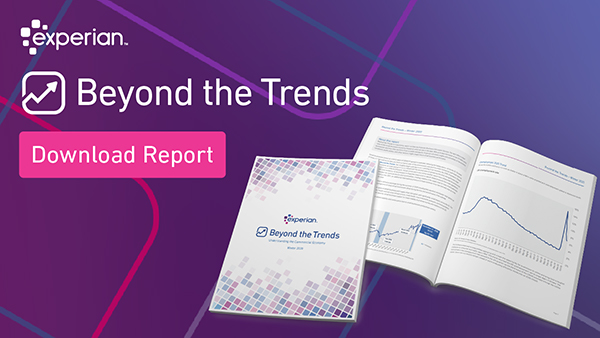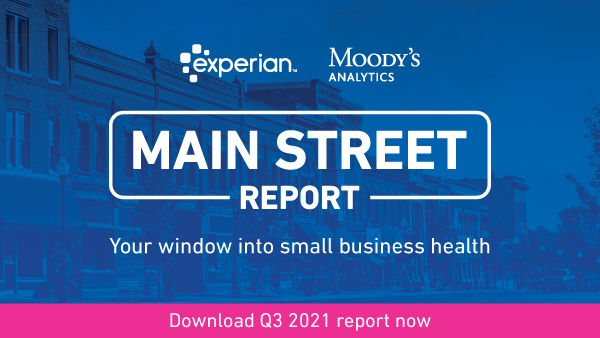Small Business Credit Insights

Experian and Oxford Economics have just released the Q1 2022 Main Street report, a window into the credit performance of small businesses complete with macroeconomic analysis. Highlights: The US economy contracted in Q1 for the first time since the pandemic-driven recession ended, but the domestic economy showed resilience in the face of Omicron, lingering supply constraints, and high inflation. Delinquency rates rose across the term periods; the 90+ days past due (DPD) climbed to 0.9 percent. Looking ahead, intensifying headwinds from more aggressive Fed tightening and tighter financial conditions will slow activity this year without stalling it. Download Q1 2022 Report Watch the Quarterly Business Credit Review Webinar Hear the experts from Experian and the lead economist from Oxford Economics unpack the latest Main Street Report. Watch the Quarterly Business Credit Review

Interest rate hike, flat unemployment rate, strong job growth are just a few of the trends we are following in the Commercial Pulse Report.

Join Experian and Oxford Economics for the Quarterly Business Credit Review webinar, your window into small business credit health.

Women-owned small businesses make up roughly 34 percent of new business starts. They are among the businesses most heavily impacted by the pandemic, and minority-owned women-led small businesses were the fastest-growing segment coming out of COVID. Despite solid growth, Women business owners face significant barriers to success. We studied a large dataset of women-owned small businesses to understand their unique needs and challenges. The result is a fascinating look at a powerful small business segment. In this talk you will learn: · Credit behaviors · Top industry sectors · Areas of opportunity for lenders Watch Recording

We've all been experiencing higher prices for food, housing, and certainly at the gasoline pump. If these economic headwinds have raised concerns about how small businesses are being impacted, we have some fresh perspectives in the Spring 2022 Beyond the Trends report. Beyond The Trends offers a unique view of the small business economy based on what we see in the data. With up to date information on over 25 million active businesses and how they perform from a credit standpoint. Here’s my quick take on what’s in our latest Beyond The Trends Report The next 12 months will be filled with headwinds and mines for small businesses. These entities have been shoring up resources, operations, building in cost increases, and creating backup supplier networks as supply chain disruption and inflation will batter the ship through 2023. Highlights: Consumers seek higher paying jobs, creating labor shortages in blue collar industries, as wage gains are being eaten away by increasing U.S. inflation. Transportation and the utility industries have seen a 69% increase in delinquent balances tied closely to the increase in U.S. inflation. A 4X increase in delinquent balances associated with mining as the US took steps to move away from fossil fuel. Commercial card lending grew 9.9% in the 4th quarter, even as delinquency rates began their upward climb. Energy Takes Center Stage Energy costs are hitting margins and impacting delivery of goods and services. US energy costs were up 27% in January according to the Bureau of Labor and Statistics. These costs have been rising sharply since March 2021 and will be exacerbated in the 1st quarter 2022 by global reaction to the Russian incursion in Ukraine. Energy supply chains will be disrupted by sanctions and higher transport costs. !function(e,i,n,s){var t="InfogramEmbeds",d=e.getElementsByTagName("script")[0];if(window[t]&&window[t].initialized)window[t].process&&window[t].process();else if(!e.getElementById(n)){var o=e.createElement("script");o.async=1,o.id=n,o.src="https://e.infogram.com/js/dist/embed-loader-min.js",d.parentNode.insertBefore(o,d)}}(document,0,"infogram-async"); Inflation Looms Consumers and small businesses will feel the pinch of lower supply and higher costs. Inflation, outside this event and on the rise, will remain above the Federal Reserve target of 2% through the end of 2022, even as the Fed raises rates and begins to reduce their balance sheet. The US supply chain will be in a slow recovery mode as infrastructure stimulus and global markets return to capacity. Small businesses are adjusting to a high demand low supply market through 2023. !function(e,i,n,s){var t="InfogramEmbeds",d=e.getElementsByTagName("script")[0];if(window[t]&&window[t].initialized)window[t].process&&window[t].process();else if(!e.getElementById(n)){var o=e.createElement("script");o.async=1,o.id=n,o.src="https://e.infogram.com/js/dist/embed-loader-min.js",d.parentNode.insertBefore(o,d)}}(document,0,"infogram-async"); Download Spring Beyond The Trends Report

Experian Business Information Services has just released the Q4 2021 Main Street Report. In addition to the Omicron surge, which significantly impacted labor and consumer engagement, an inflationary surge, the most significant increase since 1982, coupled with supply-and-demand imbalances, weighed heavily on US small businesses, making a notable impact on consumer sentiment. While workers were getting raises in a tight job market, rapid price increases eroded consumers’ earning power. Average wage earnings went up by 4.0% in Q4 ’21 vs. the previous year, yet a 7.5% increase in inflation results in a net decline in real earnings. Workers’ money is not going as far as it used to. Download the latest report to get the full detail on Q4 2021 small business credit performance. Download Q4 2021 Report Join us for the Q4 Quarterly Business Credit Review We will be going in-depth on the Q4 business credit trends in our upcoming Quarterly Business Credit Review. We look forward to sharing the latest small business trends with you. Register for Webinar

This perception of the marketplace has been a concern of consumers and small business owners, in the US, as they manage through the pandemic hampered marketplace. Small businesses are adjusting to a high demand/ low supply market that is expected to continue through 2022. The ability to move raw materials to manufacturers, products across borders, find space in warehouses, and put products on the shelf has become challenging as pandemic variants add pressure to a slowly recovering supply infrastructure. Large market participants will find disproportionate advantage, over small business competitors, widens as distributors focus on their largest clients and small clients feel cost and availability squeeze. Consumers store front engagement will increase, with a tangible delivery advantage, as distrust grows in a digital only storefronts ability to deliver on time. Here's my quick take on what's in our latest Beyond The Trends Report The Experian Winter 2021 Beyond the Trend report looks at consumer willingness and ability to spend behavior tied to the bets commercial supply chain industry participants are making, to ensure demand is met, emerging from the heart of the pandemic: Originations for new businesses, with less than a year in business and already participating in the commercial credit market, are up 157% from pre-pandemic levels. 36% of active U.S. businesses have been operating less than 1 year, as the spike in new business applications continue to be elevated. Commercial lending up 95% from same time last year to supply chain participants (Manufacturing, wholesale, retail, transportation, and warehouse) Although delinquency rates are historically low rates for wholesalers (Up 600%) and retailers (Up 101%) have been on the rise a components and inventories are slow to arrive. To operate at full capacity, small businesses will need consumers willing to spend. The fed will begin to taper and raise rates much earlier than expected, March 2022, to add downward pressure to inflation. Small businesses are betting on growth as investors view variants as a bump in the road vs a blocker. New business applications continued to roll at ~400k a month in 2021. This untapped market expansion will drive traditional lenders to reassess the risk of engaging emerging businesses in their first year of operation with limited historical commercial performance. !function(e,i,n,s){var t="InfogramEmbeds",d=e.getElementsByTagName("script")[0];if(window[t]&&window[t].initialized)window[t].process&&window[t].process();else if(!e.getElementById(n)){var o=e.createElement("script");o.async=1,o.id=n,o.src="https://e.infogram.com/js/dist/embed-loader-min.js",d.parentNode.insertBefore(o,d)}}(document,0,"infogram-async"); Supply chain bottlenecks will slowly dissipate. We expect to see variability in product availability as goods are delivered which will create scenarios of over-supply of some products while others remain tied up in transit. Lenders and creditors should monitor commercial health of businesses they interact with directly and indirectly to ensure portfolio stability and accurate risk based pricing. 2022 will be a recovery year for the US market. Consumers keep shopping! Small businesses keep fighting! The shelves will be full soon. Download Winter 21/22 Report

Experian and Moody's Analytics have just released the Q3 2021 Main Street Report. The report brings deep insight into the overall financial well-being of the small-business landscape and offers commentary on business credit trends and what they mean for lenders and small businesses. Labor shortages, wage pressure, and supply chain issues challenge small businesses Small business credit performance was mixed in the third quarter as businesses dealt with the COVID-19 Delta variant. Early-stage delinquency rates rose modestly while late state delinquency and bankruptcy rates fell decisively. With daily COVID cases falling, demand for goods and services should rise in coming quarters. Downside risks are concentrated on the supply side with businesses struggling to hire workers and dealing with supply chain stress. Early-stage delinquency rates rose in the third quarter with servicers reporting that 1.27% of small business credit balances were 31-90 days past due. While higher than the second quarter’s 1.19% rate, performance was only slightly worse than a year ago and significantly better than the pandemic high of 1.66%. Perhaps more notable was the sharp drop in late-stage delinquency, with 1.92% of balances reported as being more than 91 days past due. Supply chain issues are impacting both the availability and price of key inputs. Nowhere is this more apparent than in the semiconductor industry, where bottlenecks have shut down the manufacture of entire carlines. If you would like to get the full analysis of the data behind the latest Main Street Report, watch our Quarterly Business Credit Review webinar. Just scan the code or go to the short link and remember to download your copy of the latest report. Download Latest Report

The Beyond The Trends Report - Fall 2021 Out Now! Did you know that there are about a million restaurants in the U.S? And those restaurants employ nine million people? As we prepared the latest Beyond the Trends report for Fall 2021, I took a deep dive into the restaurant industry in our small business data set to explore how restaurants were performing through the pandemic and how resilient they are now. Here's a quick snippet — the SBA's Restaurant Revitalization fund delivered 74,498 grants accounting for $22.4B in funds for May through June of 2021. It's a shot in the arm for restaurants. Here's how the funds were distributed based on annual sales. Distribution of Restaurants by Annual Sales Size source: SBA, Experian The RRF program has done well servicing a diverse set of applicants and underserved community segments. The Women-owned businesses made up almost half of the recipients Veteran-owned businesses were only 5% of the program. Veterans received fewer loans overall but had much higher average loan amounts awarded Restaurants in LMI designated areas were over a quarter of the program Restaurants in lower socioeconomic areas were over a third of the program's recipients Would you like to learn about this and other trends impacting small business? Download the Fall 2021 Beyond The Trends Report! Download the Latest Report
